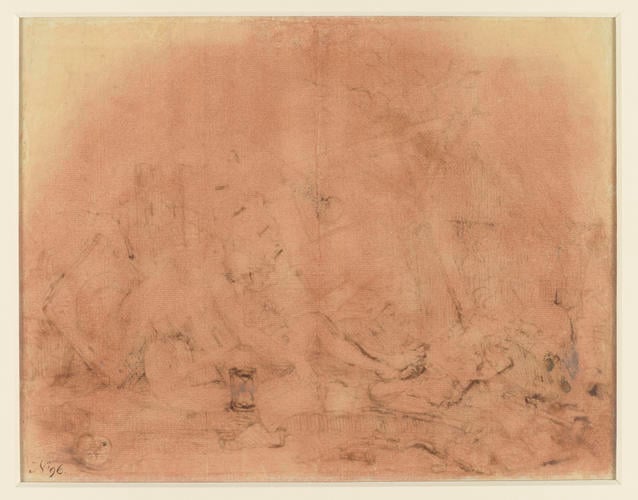-
1 of 253523 objects
The Bathos 1764
Pen and ink over red chalk and pencil, indented for transfer | 25.5 x 33.1 cm (sheet of paper) | RCIN 913466

William Hogarth (1697-1764)
The Bathos 1764

William Hogarth (1697-1764)
The Bathos 1764


-
A drawing of a winged bearded figure sitting among a pile of objects, e.g. timepieces, bells, an axe, an old sign, etc. He is smoking a pipe and puffing out smoke from his mouth with the word FINIS contained.
This is a vigorous study for Hogarth's last engraving, published on 3 March 1764, less than eight months before his death. Hogarth knew that his health was failing and advertisements for the print announcing its publication stated that it was intended to 'serve as a Tail-Piece to all the Author's Engraved Works, when bound up together'.
The feelings expressed, and Hogarth's manner of expressing them, are complex. The image is a comprehensive vanitas: the exhausted figure of winged Time breathes his last, leaning on ruins, a sundial and a tombstone, with broken pipe and scythe, clutching a Last Will and Testament, at his feet a cracked bell, a broken palette, and a derelict inn-sign (inscribed The World's End in the print), gallows and a blasted tree beyond. The full title of the engraving is The Bathos, or Manner of Sinking, in Sublime Paintings, inscribed to the Dealers in Dark Paintings, with a footnote See the manner of disgracing ye most Serious Subjects, in many celebrated Old Pictures; by introducing Low, absurd, obscene & often prophane Circumstances into them.
This is a genuinely pessimistic, even bitter sentiment. Hogarth, characteristically, saw degradation in the supposedly trivial incidental details of Old Master paintings. The sarcastic references to 'celebrated Old Pictures' and 'Dealers in Dark Paintings' are an attack on the unbroken vogue for imported Old Masters; to this he added a side-swipe at the growing taste for the Sublime in art (recently codified by Edmund Burke in his Philosophical Enquiry of 1756), equating the dark treatments of sublime paintings with the darkened varnish of the Old Masters. Hogarth's gloom was no doubt compounded by his own physical decline, and the deep weariness of the image reflects a recognition that his life's ambition, the establishment of a noble and independent English school of painting, had been (by his own standards) in vain.
Although there are significant differences of detail between the drawing and the print, those portions of the composition that agree are on the same scale. The sheet was rubbed with red chalk on the reverse and many of the outlines were incised to transfer the design to the copper plate; the final changes in detail must have been effected by Hogarth on the plate itself.
Catalogue entry from Royal Treasures, A Golden Jubilee Celebration, London 2002Provenance
John Greenwood; H.P. Standly; his sale, Christie's, London, 19 April 1845 (884); bought by Colnaghi; Royal Collection by 1877
-
Creator(s)
-
Medium and techniques
Pen and ink over red chalk and pencil, indented for transfer
Measurements
25.5 x 33.1 cm (sheet of paper)
Object type(s)
Other number(s)
RL 13466